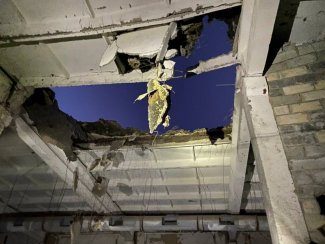Russia threatens with a dirty bomb. 242nd day of the war

The Donbas remains the main arena of fighting. Ukrainian troops repelled further attempts to attack Bakhmut, its outskirts, and surrounding villages. Aggressor forces also pressed unsuccessfully east of Siversk, on the outskirts of Avdiivka, northwest of Horlivka and in an arc west of Donetsk. Ukrainian reports indicate that on 21 October, the Russians also attacked the area of Lyman, which had been recaptured by the defenders a few weeks earlier (this may have been a Russian sabotage and reconnaissance group). The invaders also renewed attacks in the Kharkiv Oblast bordering Russia, west and east of Vovchansk and northeast of Velykyi Burluk. Ukrainian troops, in turn, are attempting to break the enemy’s defence lines on the border of the Kharkiv and Luhansk oblasts east of Kupiansk. Some Ukrainian sources confirm that fighting is also taking place in Kherson Oblast, but attempts to break Russian positions between Davydiv Brid and Dudchany are still unsuccessful. The invaders are said to be preparing for street fighting in Kherson and systematically repairing and reinforcing the Dnieper river crossings.
On 22 October, the head of the occupation administration of the Nova Kakhovka raion announced that the Kakhovka Reservoir was being drained for three days, supposedly to reduce the magnitude of the natural disaster should the Ukrainian side destroy the dam. Two days later, the head of Ukrainian military intelligence, Kyrylo Budanov, accused the Russians of intending to destroy the facility. At the same time, he pointed out that this would halt the Ukrainian counter-offensive in the Kherson Oblast for a fortnight at most while preventing the functioning of the North Crimean Canal (reopened by the occupying forces to supply water to Crimea) and the Zaporizhzhia Nuclear Power Plant.
The invaders launched another massive strike against Ukraine’s energy infrastructure on the same day. Rocket and kamikaze drone attacks took place in Cherkasy, Chernihiv, Chernivtsi, Khmelnytskyi, Kirovohrad, Kyiv, Mykolaiv, Odesa, Rivne, Volyn and Zaporizhzhia oblasts. According to the Ukrainian General Staff’s collective information, the defenders shot down 20 out of 40 missiles and 11 out of 16 drones. In addition, rockets fell on Mykolaiv and Zaporizhzhia, while Kharkiv, Nikopol and Vovchansk were also shelled. The Russian artillery and air force did not stop striking enemy army positions and facilities along the line of contact and in the border areas of Chernihiv and Sumy oblasts. The Ukrainians, meanwhile, were to continue their sabotage operations in Russia’s Belgorod Oblast.
On 24 October, Budanov presented expanded data on the missiles and kamikaze drones used by the enemy. In addition to Iskander missiles, of which 13% of the 24 February stock was to remain, the aggressor’s army is to maintain a so-called safe stock level (at least 30%, according to Budanov) of the main types of cruise missiles – Kalibr (43%) and Ch-101/Ch-555 (45%). Russia ordered nearly 1,700 Shahed-136, Shahed-131 and Mohajer-6 drones from Iran, of which it has received two batches of 300 each. By 22 October, Russia had used 330 drones, of which 222 (around 70%) had been shot down. The figures differ from those reported a day earlier by Yuriy Ihnat, spokesman for the Ukrainian Air Force Command, who noted that a total of 273 Shahed-136 and four Mohajer-6 drones had been shot down. Defence Minister Oleksii Reznikov, on the other hand, put the overall effectiveness of Ukraine’s air defence at 60%.
Germany handed Kyiv the first TRML-4D radar station for the previously delivered IRIS-T air defence system battery (in total, the Ukrainian army is to receive four such radars – one for each battery), five armoured recovery vehicles, seven heavy and five medium bridge systems, 167,000 small arms ammunition, 100 tents, 183 generators and winter clothing (116,000 jackets, 80,000 trousers and 240,000 caps). The Netherlands, in turn, announced the transfer of €500 million to Ukraine as part of its sixth support package.
On 23 October, Russian Defence Minister Sergei Shoigu held talks with his counterparts from the US, France, the UK and Turkey. Their main topic was a warning that an adversary was allegedly ready to use a dirty bomb in southern Ukraine. Earlier, Russia’s RIA Novosti news agency reported that his forces were preparing to “detonate a nuclear bomb” to accuse Moscow of using weapons of mass destruction. President Volodymyr Zelensky saw Shoigu’s statement as a prelude to a further escalation of the conflict, while Foreign Minister Dmytro Kuleba described it as absurd.
The situation for Russian forces in the Kherson area is deteriorating. The General Staff of Ukraine confirmed that, as of 19 October, in Beryslav, which lies about 80km northeast of it, all organs of the occupation authorities had ceased to function, and collaborators had left the city. On 22 October, the occupation administration demanded that the inhabitants of Kherson “immediately leave the city and move to the left bank of the Dnieper”. According to it, tens of thousands of people have already been evacuated, and most of them are headed to Crimea.
Also, on 22 October, the governor of the Belgorod Oblast announced that around 500 residents of Belgorod and areas bordering Ukraine would be evacuated to the Moscow area. In the oblast, the protection of energy facilities and transport routes has been strengthened, and remote working has been recommended for border towns. In Kursk Oblast, on the other hand, the construction of two fortified defence lines has been completed.
According to the Ukrainian army, special services are intensifying counterintelligence activities in the Pinsk and Stolin raions (Brest Oblast) of Belarus. Video recording, including the use of car cameras, has been banned. The steps taken are intended to prevent the transmission of information about the movements of Russian units. In cooperation with the FSB, local services detain Russians wishing to avoid military service and attempting to enter Turkey via Minsk.
On 21 October, the Ukrainian Armed Forces initiated an information operation targeting Belarusian citizens. A video in Russian was published on social media appealing to them not to fight against Ukraine and to boycott any orders to join the war.
A day later, the Security Service of Ukraine announced the arrest in Zaporizhzhia of 83-year-old Vyacheslav Bohuslayev, former director and owner of the strategic aviation industry company Motor Sich (nationalised last year) and once a prominent political activist. He is suspected of treason against the state and involvement in the illegal sale of engines and spare parts to Russia through intermediaries from Asia, the Middle East and Europe. The SBU collected evidence of his collaboration with representatives of the Russian arms company Rostech. Goods supplied from Ukraine went to manufacturers and repair facilities of Russian military helicopters of the Mi-8, Ka-52 ‘Alligator’ and Mi-28N types.
Commentary
- The warnings about Ukraine’s alleged readiness to use dirty nuclear weapons made by the Russian Defence Minister in talks with his counterparts from NATO countries should be regarded as an attempt at blackmail. Threatening a drastic escalation of the conflict and emphasising Kyiv’s alleged possibility of provocation against the Russian Federation is a regular part of the Russian game. This argument is intended to sow panic in the west and, as a result, lead to the situation expected by the Kremlin, in which concerned partners convince the Ukrainians to halt offensive actions and reduce military aid.
- Both sides have consistently accused each other of intending to destroy the Kakhovka Reservoir dam and thus create a natural disaster. From a military perspective, such a move can only benefit the Russians. In the event of a break in their defence line in the Kherson Oblast and the need to withdraw troops to the left bank of the Dnieper, blowing up the facility could periodically slow down the Ukrainians’ advance, as well as destroy some of their forces (if these are then on the floodplain). However, the breach of the dam does not have to occur due to deliberate action by the parties. The draining of the water carried out by the occupiers indicates that they fear its accidental destruction and a situation in which Russian soldiers would become the main victims (apart from the local population). This cannot be ruled out, all the more so, as the dam’s structure may have already been partially breached due to Ukrainian attacks on the Kakhovsky bridge that runs across it. The lowering of the water table in the Kakhovka Reservoir means that if the dam breaks, the flood will cover a much smaller area and is unlikely to reach Kherson. While being able to decide on the water level in the reservoir, which will be relatively easy to raise again in the autumn season, the Russian side still retains the possibility of using the dam as a ‘weapon’.
- The data reported by the Ukrainian side on the downing of Russian missiles and drones shows that Kyiv is trying to reconcile two messages. In its messages to the Ukrainian public, it is trying to demonstrate that the air defence is relatively effective in combating Russian attacks, which generate costs for the Russian army rather than profits (considering the value of the missiles fired and the problems with replenishing Russian arsenals due to Western sanctions). In its message to the West, Kyiv is trying to demonstrate that without the delivery of a far greater number of modern air defence systems, including long-range systems, it is impossible to shield the country’s territory (at the moment, the army has only one battery of the IRIS-T short-range system, another NASAMS medium-range system is about to arrive, and deliveries announced for 2023 are not much greater). The ongoing destruction of energy infrastructure since 10 October is a direct confirmation of the need to strengthen Ukraine’s air defence as soon as possible.
- The detention of the former owner of the Motor Sich company is an example of the punishment of politicians and business people with close contact with the aggressor. The indictment on charges of supplying products to the Russian arms industry revealed the weakness of Ukraine’s counterintelligence and military intelligence services, which have so far failed to respond to this practice. Bohuslayev’s arrest may trigger personnel changes in the special services and/or the management of the arms concern Ukroboronprom.





